Diabetes and Indigenous Australians: A Health Issue Analysis
VerifiedAdded on 2021/02/19
|9
|2310
|100
Essay
AI Summary
This essay provides an in-depth analysis of diabetes as a significant health issue affecting Aboriginal and Torres Strait Islander Australians. The essay begins by defining diabetes and its impact on the body, followed by an examination of current statistics that highlight the disproportionate burden of the disease on Indigenous communities compared to non-Indigenous Australians. It explores how the history of colonisation has contributed to the development and progression of diabetes within these communities, emphasizing the disruption of traditional lifestyles and the resulting health disparities. The essay also identifies and discusses the impact of two key social determinants of health: poverty and socio-economic position, and how these factors influence access to healthcare and overall health outcomes. Furthermore, it addresses the cultural implications and obstacles in addressing this health issue, discussing barriers to healthcare and the importance of culturally sensitive approaches. The essay concludes by summarizing the key findings and emphasizing the need for comprehensive strategies to improve diabetes management and overall health for Aboriginal and Torres Strait Islander populations.
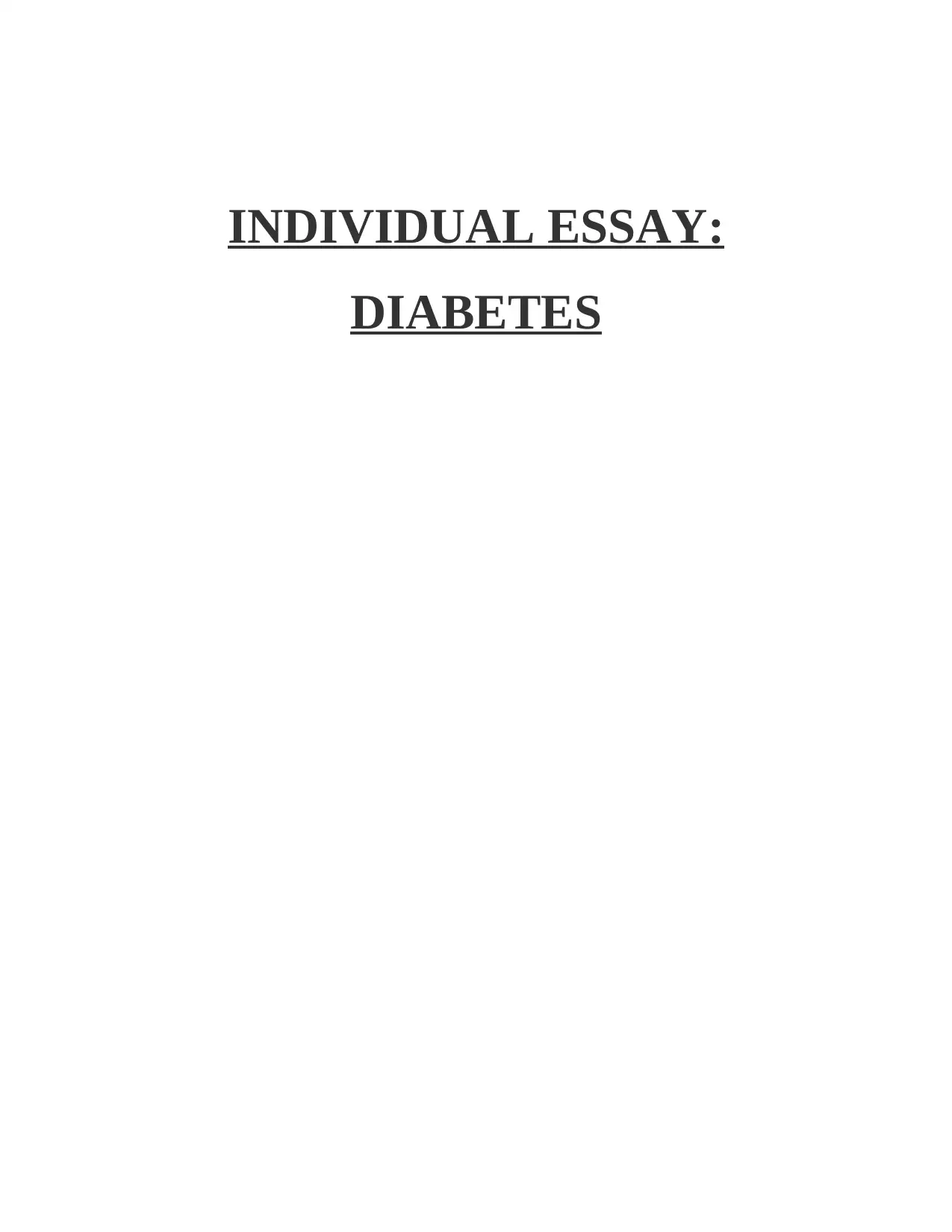
INDIVIDUAL ESSAY:
DIABETES
DIABETES
Paraphrase This Document
Need a fresh take? Get an instant paraphrase of this document with our AI Paraphraser

TABLE OF CONTENTS
INTRODUCTION...........................................................................................................................1
MAIN BODY ..................................................................................................................................1
1. Define health issue...................................................................................................................1
2. Use current statistic to define the burden of health issue for Aboriginal and Torres strait
islander with non aboriginal and Torres and strait islander Australians......................................1
3. Define how history of colonisation has impact on development on health issue for
Aboriginal and Torres islander Australians.................................................................................4
4. Identification on impact two social determinants of health on development and progression
of health issue..............................................................................................................................4
5. Discussion on cultural implication and obstacles to address this health issue for aboriginal
and Torres islander Australians...................................................................................................5
CONCLUSION ...............................................................................................................................5
REFERENCES................................................................................................................................7
INTRODUCTION...........................................................................................................................1
MAIN BODY ..................................................................................................................................1
1. Define health issue...................................................................................................................1
2. Use current statistic to define the burden of health issue for Aboriginal and Torres strait
islander with non aboriginal and Torres and strait islander Australians......................................1
3. Define how history of colonisation has impact on development on health issue for
Aboriginal and Torres islander Australians.................................................................................4
4. Identification on impact two social determinants of health on development and progression
of health issue..............................................................................................................................4
5. Discussion on cultural implication and obstacles to address this health issue for aboriginal
and Torres islander Australians...................................................................................................5
CONCLUSION ...............................................................................................................................5
REFERENCES................................................................................................................................7

INTRODUCTION
Diabetes is disease that take place at time blood glucose called blood sugar level tends to
get too high. It can damage the eyes, nerves, kidneys and other body parts. It may have impact on
sexual life and can enhance the risk of heart disease and stroke (Bennet, Zöller and Groop,
2018). On the other hand, this is defined as disorder in which body do not produce insulin or not
use it efficiently.
The present report is based on health issues as “Diabetes” and this impact on Aboriginal
and Torres islander Australians. Moreover, report will identify the social determinants of health
to bring development and progression of health issues. Lastly, assignment will discuss cultural
implication and obstacles to address health issues for Indigenous community.
MAIN BODY
1. Define health issue.
Diabetes is defined as health issue that highly affect that how body uses blood sugar
level. Therefore, glucose is vital to health and it is crucial source of energy for the cells that
make body muscles and tissues (De Wit, Fenenga and Meijering, 2018). On the other hand,
diabetes is major contributor to heart disease, kidney, stroke and vision loss. It can be caused at
time when immune system of body become weak and system for fighting ill health attacks and
destroys the insulin producing beta cells of the pancreas. This is a chronic disease that associated
with aberrant high level of sugar glucose in blood.
2. Use current statistic to define the burden of health issue for indigenous and non indigenous
community.
Diabetes can be defined as chronic condition in which glucose levels in blood becomes
too advanced as body produce little or no insulin (Reading and Greenwood, 2018). Therefore,
this can be stated that high blood glucose level can harm various part of the body, especially
heart, eyes, kidneys, tube, mental health problems and can leads to permanent disability.
1
Diabetes is disease that take place at time blood glucose called blood sugar level tends to
get too high. It can damage the eyes, nerves, kidneys and other body parts. It may have impact on
sexual life and can enhance the risk of heart disease and stroke (Bennet, Zöller and Groop,
2018). On the other hand, this is defined as disorder in which body do not produce insulin or not
use it efficiently.
The present report is based on health issues as “Diabetes” and this impact on Aboriginal
and Torres islander Australians. Moreover, report will identify the social determinants of health
to bring development and progression of health issues. Lastly, assignment will discuss cultural
implication and obstacles to address health issues for Indigenous community.
MAIN BODY
1. Define health issue.
Diabetes is defined as health issue that highly affect that how body uses blood sugar
level. Therefore, glucose is vital to health and it is crucial source of energy for the cells that
make body muscles and tissues (De Wit, Fenenga and Meijering, 2018). On the other hand,
diabetes is major contributor to heart disease, kidney, stroke and vision loss. It can be caused at
time when immune system of body become weak and system for fighting ill health attacks and
destroys the insulin producing beta cells of the pancreas. This is a chronic disease that associated
with aberrant high level of sugar glucose in blood.
2. Use current statistic to define the burden of health issue for indigenous and non indigenous
community.
Diabetes can be defined as chronic condition in which glucose levels in blood becomes
too advanced as body produce little or no insulin (Reading and Greenwood, 2018). Therefore,
this can be stated that high blood glucose level can harm various part of the body, especially
heart, eyes, kidneys, tube, mental health problems and can leads to permanent disability.
1
⊘ This is a preview!⊘
Do you want full access?
Subscribe today to unlock all pages.

Trusted by 1+ million students worldwide
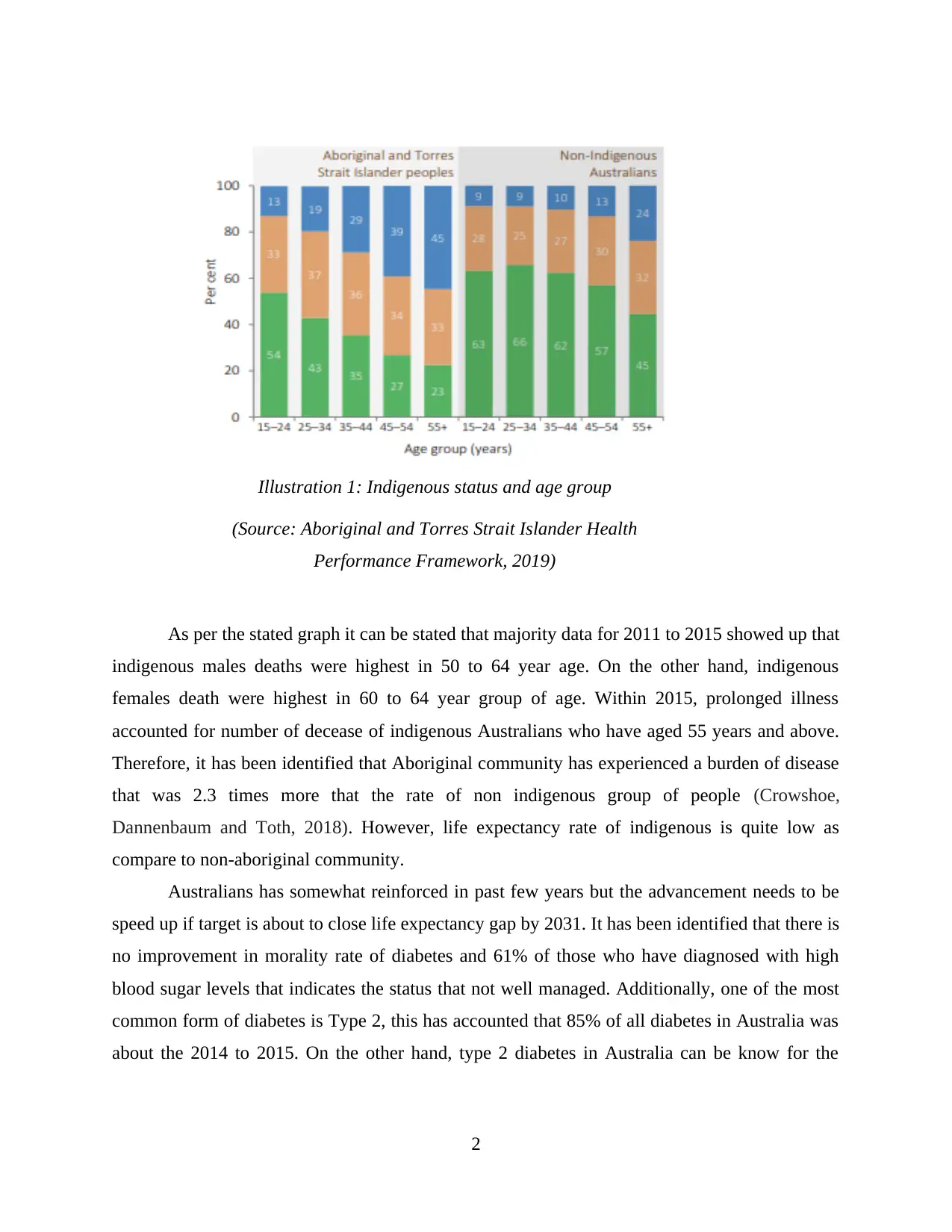
As per the stated graph it can be stated that majority data for 2011 to 2015 showed up that
indigenous males deaths were highest in 50 to 64 year age. On the other hand, indigenous
females death were highest in 60 to 64 year group of age. Within 2015, prolonged illness
accounted for number of decease of indigenous Australians who have aged 55 years and above.
Therefore, it has been identified that Aboriginal community has experienced a burden of disease
that was 2.3 times more that the rate of non indigenous group of people (Crowshoe,
Dannenbaum and Toth, 2018). However, life expectancy rate of indigenous is quite low as
compare to non-aboriginal community.
Australians has somewhat reinforced in past few years but the advancement needs to be
speed up if target is about to close life expectancy gap by 2031. It has been identified that there is
no improvement in morality rate of diabetes and 61% of those who have diagnosed with high
blood sugar levels that indicates the status that not well managed. Additionally, one of the most
common form of diabetes is Type 2, this has accounted that 85% of all diabetes in Australia was
about the 2014 to 2015. On the other hand, type 2 diabetes in Australia can be know for the
2
Illustration 1: Indigenous status and age group
(Source: Aboriginal and Torres Strait Islander Health
Performance Framework, 2019)
indigenous males deaths were highest in 50 to 64 year age. On the other hand, indigenous
females death were highest in 60 to 64 year group of age. Within 2015, prolonged illness
accounted for number of decease of indigenous Australians who have aged 55 years and above.
Therefore, it has been identified that Aboriginal community has experienced a burden of disease
that was 2.3 times more that the rate of non indigenous group of people (Crowshoe,
Dannenbaum and Toth, 2018). However, life expectancy rate of indigenous is quite low as
compare to non-aboriginal community.
Australians has somewhat reinforced in past few years but the advancement needs to be
speed up if target is about to close life expectancy gap by 2031. It has been identified that there is
no improvement in morality rate of diabetes and 61% of those who have diagnosed with high
blood sugar levels that indicates the status that not well managed. Additionally, one of the most
common form of diabetes is Type 2, this has accounted that 85% of all diabetes in Australia was
about the 2014 to 2015. On the other hand, type 2 diabetes in Australia can be know for the
2
Illustration 1: Indigenous status and age group
(Source: Aboriginal and Torres Strait Islander Health
Performance Framework, 2019)
Paraphrase This Document
Need a fresh take? Get an instant paraphrase of this document with our AI Paraphraser
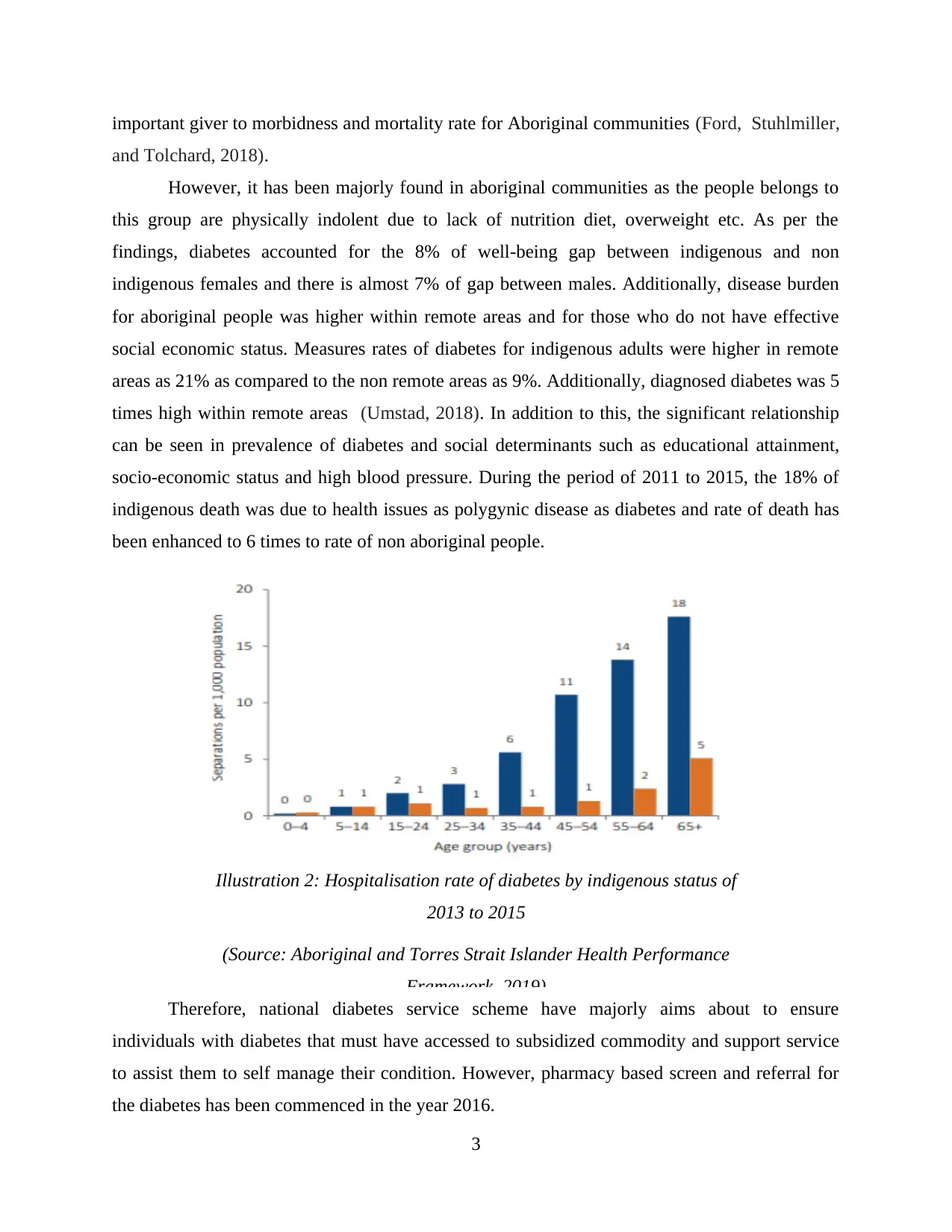
important giver to morbidness and mortality rate for Aboriginal communities (Ford, Stuhlmiller,
and Tolchard, 2018).
However, it has been majorly found in aboriginal communities as the people belongs to
this group are physically indolent due to lack of nutrition diet, overweight etc. As per the
findings, diabetes accounted for the 8% of well-being gap between indigenous and non
indigenous females and there is almost 7% of gap between males. Additionally, disease burden
for aboriginal people was higher within remote areas and for those who do not have effective
social economic status. Measures rates of diabetes for indigenous adults were higher in remote
areas as 21% as compared to the non remote areas as 9%. Additionally, diagnosed diabetes was 5
times high within remote areas (Umstad, 2018). In addition to this, the significant relationship
can be seen in prevalence of diabetes and social determinants such as educational attainment,
socio-economic status and high blood pressure. During the period of 2011 to 2015, the 18% of
indigenous death was due to health issues as polygynic disease as diabetes and rate of death has
been enhanced to 6 times to rate of non aboriginal people.
Therefore, national diabetes service scheme have majorly aims about to ensure
individuals with diabetes that must have accessed to subsidized commodity and support service
to assist them to self manage their condition. However, pharmacy based screen and referral for
the diabetes has been commenced in the year 2016.
3
Illustration 2: Hospitalisation rate of diabetes by indigenous status of
2013 to 2015
(Source: Aboriginal and Torres Strait Islander Health Performance
Framework, 2019)
and Tolchard, 2018).
However, it has been majorly found in aboriginal communities as the people belongs to
this group are physically indolent due to lack of nutrition diet, overweight etc. As per the
findings, diabetes accounted for the 8% of well-being gap between indigenous and non
indigenous females and there is almost 7% of gap between males. Additionally, disease burden
for aboriginal people was higher within remote areas and for those who do not have effective
social economic status. Measures rates of diabetes for indigenous adults were higher in remote
areas as 21% as compared to the non remote areas as 9%. Additionally, diagnosed diabetes was 5
times high within remote areas (Umstad, 2018). In addition to this, the significant relationship
can be seen in prevalence of diabetes and social determinants such as educational attainment,
socio-economic status and high blood pressure. During the period of 2011 to 2015, the 18% of
indigenous death was due to health issues as polygynic disease as diabetes and rate of death has
been enhanced to 6 times to rate of non aboriginal people.
Therefore, national diabetes service scheme have majorly aims about to ensure
individuals with diabetes that must have accessed to subsidized commodity and support service
to assist them to self manage their condition. However, pharmacy based screen and referral for
the diabetes has been commenced in the year 2016.
3
Illustration 2: Hospitalisation rate of diabetes by indigenous status of
2013 to 2015
(Source: Aboriginal and Torres Strait Islander Health Performance
Framework, 2019)
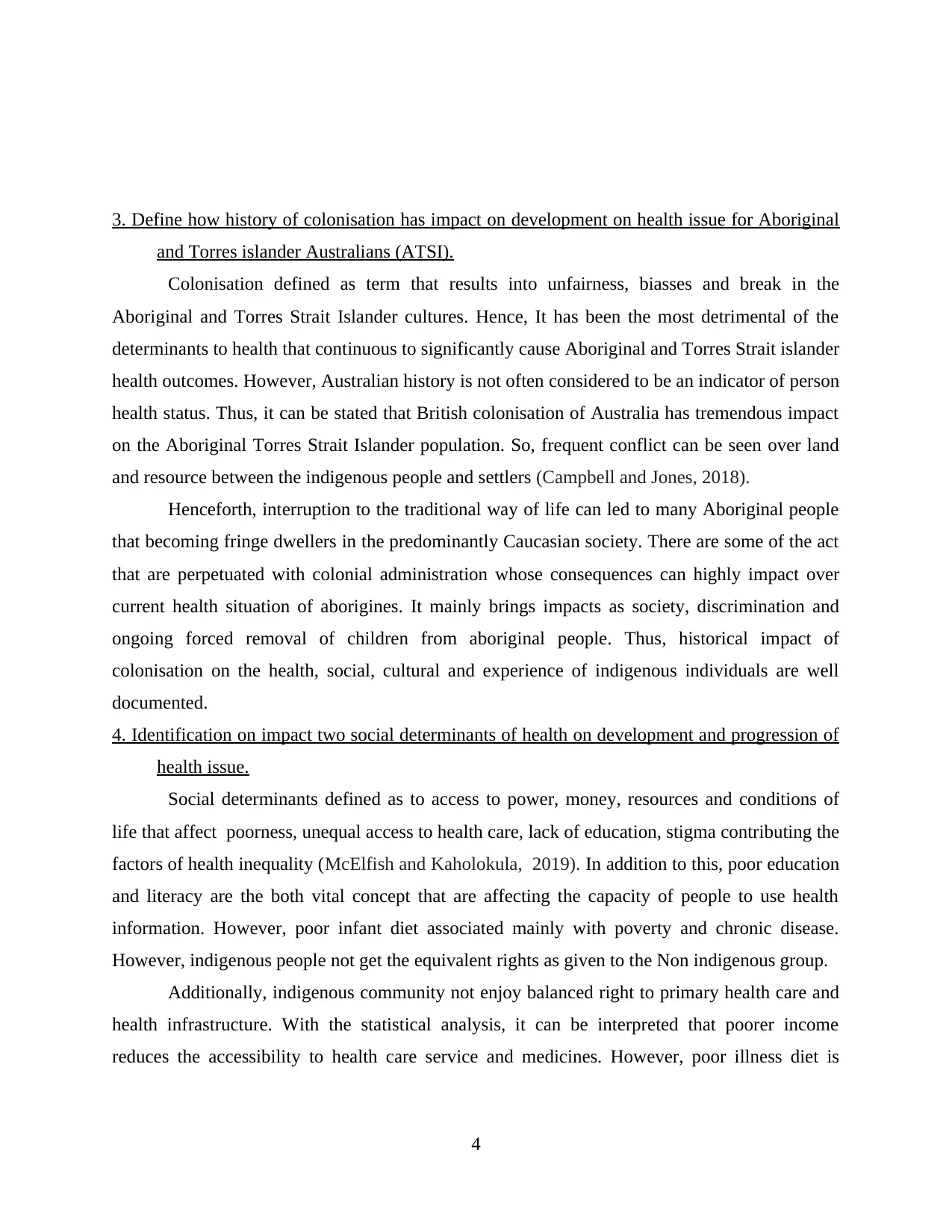
3. Define how history of colonisation has impact on development on health issue for Aboriginal
and Torres islander Australians (ATSI).
Colonisation defined as term that results into unfairness, biasses and break in the
Aboriginal and Torres Strait Islander cultures. Hence, It has been the most detrimental of the
determinants to health that continuous to significantly cause Aboriginal and Torres Strait islander
health outcomes. However, Australian history is not often considered to be an indicator of person
health status. Thus, it can be stated that British colonisation of Australia has tremendous impact
on the Aboriginal Torres Strait Islander population. So, frequent conflict can be seen over land
and resource between the indigenous people and settlers (Campbell and Jones, 2018).
Henceforth, interruption to the traditional way of life can led to many Aboriginal people
that becoming fringe dwellers in the predominantly Caucasian society. There are some of the act
that are perpetuated with colonial administration whose consequences can highly impact over
current health situation of aborigines. It mainly brings impacts as society, discrimination and
ongoing forced removal of children from aboriginal people. Thus, historical impact of
colonisation on the health, social, cultural and experience of indigenous individuals are well
documented.
4. Identification on impact two social determinants of health on development and progression of
health issue.
Social determinants defined as to access to power, money, resources and conditions of
life that affect poorness, unequal access to health care, lack of education, stigma contributing the
factors of health inequality (McElfish and Kaholokula, 2019). In addition to this, poor education
and literacy are the both vital concept that are affecting the capacity of people to use health
information. However, poor infant diet associated mainly with poverty and chronic disease.
However, indigenous people not get the equivalent rights as given to the Non indigenous group.
Additionally, indigenous community not enjoy balanced right to primary health care and
health infrastructure. With the statistical analysis, it can be interpreted that poorer income
reduces the accessibility to health care service and medicines. However, poor illness diet is
4
and Torres islander Australians (ATSI).
Colonisation defined as term that results into unfairness, biasses and break in the
Aboriginal and Torres Strait Islander cultures. Hence, It has been the most detrimental of the
determinants to health that continuous to significantly cause Aboriginal and Torres Strait islander
health outcomes. However, Australian history is not often considered to be an indicator of person
health status. Thus, it can be stated that British colonisation of Australia has tremendous impact
on the Aboriginal Torres Strait Islander population. So, frequent conflict can be seen over land
and resource between the indigenous people and settlers (Campbell and Jones, 2018).
Henceforth, interruption to the traditional way of life can led to many Aboriginal people
that becoming fringe dwellers in the predominantly Caucasian society. There are some of the act
that are perpetuated with colonial administration whose consequences can highly impact over
current health situation of aborigines. It mainly brings impacts as society, discrimination and
ongoing forced removal of children from aboriginal people. Thus, historical impact of
colonisation on the health, social, cultural and experience of indigenous individuals are well
documented.
4. Identification on impact two social determinants of health on development and progression of
health issue.
Social determinants defined as to access to power, money, resources and conditions of
life that affect poorness, unequal access to health care, lack of education, stigma contributing the
factors of health inequality (McElfish and Kaholokula, 2019). In addition to this, poor education
and literacy are the both vital concept that are affecting the capacity of people to use health
information. However, poor infant diet associated mainly with poverty and chronic disease.
However, indigenous people not get the equivalent rights as given to the Non indigenous group.
Additionally, indigenous community not enjoy balanced right to primary health care and
health infrastructure. With the statistical analysis, it can be interpreted that poorer income
reduces the accessibility to health care service and medicines. However, poor illness diet is
4
⊘ This is a preview!⊘
Do you want full access?
Subscribe today to unlock all pages.

Trusted by 1+ million students worldwide

mainly associated with poverty and prolonged sickness later in life. Therefore, the two social
determinants defined in following manner as are-
Poverty- If a group of people have lack of human needs just because they cannot afford the basic
necessities. Additionally, human needs clean water, nutrition, education, clothing and shelter etc.
Therefore, poverty is one of the major cause that can impact over the living style of individuals.
However, poverty bring injustice to the health of people as they cannot afford their basic and this
leads to impact on their health Chen and et.al., (2019).
Socio-economic position- Resource based measures defined as that materials and social
resources inclusive of income, educational credentials and wealth has huge impact over
individuals. Henceforth, the inequalities in health distribution, quality of life and resources are
increasing in United states and at global level. Therefore, the impact of socio-economic position
can be mitigated if the circumstances are majorly formed by the dispersion of monetary system
and resources at global level.
5. Discussion on cultural implication and obstacles to address this health issue for non aboriginal
people.
Access barriers to wellness care for minority population is one of crucial feature of
medical, health, social science. Henceforth, the cultural barrier mainly considered by the
aboriginal patients and health practitioners (Stuhlmiller and Tolchard, 2018). Thus, health
inequality mainly exists among indigenous community and culture barriers are said to be vital
components in addressing aboriginal health inequality.
On the other hand, Health care professional must take initiatives to have reduction in
racial and ethical disparities in healthcare. Better and improved roles of nurses and health care
professional can assist to ATSI people to have enhancement in equity to access to the health care
and help aboriginal people to attain better levels of health.
CONCLUSION
Hereby, it can be concluded that diabetes is considered to be a chronic disease that is
associated with high level of sugar glucose in the blood. The present report is based on the health
issue as diabetes and its impact on Aboriginal and non aboriginal communities within Australia.
However, report has covered things as current statistical graph that defines burden of
health issues between aboriginal and non-aboriginal communities and two social determinants
has been explained to know access of health issues over indigenous group.
5
determinants defined in following manner as are-
Poverty- If a group of people have lack of human needs just because they cannot afford the basic
necessities. Additionally, human needs clean water, nutrition, education, clothing and shelter etc.
Therefore, poverty is one of the major cause that can impact over the living style of individuals.
However, poverty bring injustice to the health of people as they cannot afford their basic and this
leads to impact on their health Chen and et.al., (2019).
Socio-economic position- Resource based measures defined as that materials and social
resources inclusive of income, educational credentials and wealth has huge impact over
individuals. Henceforth, the inequalities in health distribution, quality of life and resources are
increasing in United states and at global level. Therefore, the impact of socio-economic position
can be mitigated if the circumstances are majorly formed by the dispersion of monetary system
and resources at global level.
5. Discussion on cultural implication and obstacles to address this health issue for non aboriginal
people.
Access barriers to wellness care for minority population is one of crucial feature of
medical, health, social science. Henceforth, the cultural barrier mainly considered by the
aboriginal patients and health practitioners (Stuhlmiller and Tolchard, 2018). Thus, health
inequality mainly exists among indigenous community and culture barriers are said to be vital
components in addressing aboriginal health inequality.
On the other hand, Health care professional must take initiatives to have reduction in
racial and ethical disparities in healthcare. Better and improved roles of nurses and health care
professional can assist to ATSI people to have enhancement in equity to access to the health care
and help aboriginal people to attain better levels of health.
CONCLUSION
Hereby, it can be concluded that diabetes is considered to be a chronic disease that is
associated with high level of sugar glucose in the blood. The present report is based on the health
issue as diabetes and its impact on Aboriginal and non aboriginal communities within Australia.
However, report has covered things as current statistical graph that defines burden of
health issues between aboriginal and non-aboriginal communities and two social determinants
has been explained to know access of health issues over indigenous group.
5
Paraphrase This Document
Need a fresh take? Get an instant paraphrase of this document with our AI Paraphraser
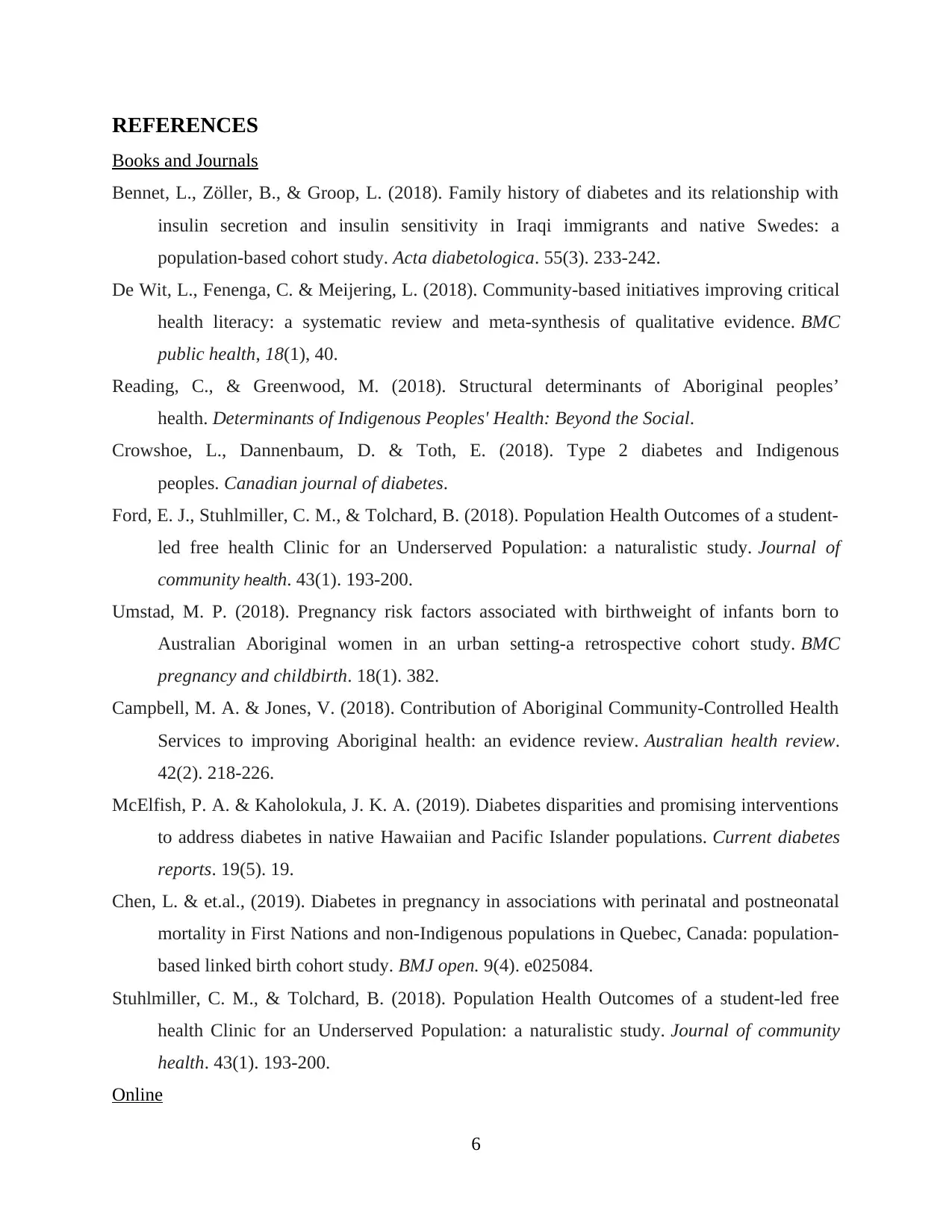
REFERENCES
Books and Journals
Bennet, L., Zöller, B., & Groop, L. (2018). Family history of diabetes and its relationship with
insulin secretion and insulin sensitivity in Iraqi immigrants and native Swedes: a
population-based cohort study. Acta diabetologica. 55(3). 233-242.
De Wit, L., Fenenga, C. & Meijering, L. (2018). Community-based initiatives improving critical
health literacy: a systematic review and meta-synthesis of qualitative evidence. BMC
public health, 18(1), 40.
Reading, C., & Greenwood, M. (2018). Structural determinants of Aboriginal peoples’
health. Determinants of Indigenous Peoples' Health: Beyond the Social.
Crowshoe, L., Dannenbaum, D. & Toth, E. (2018). Type 2 diabetes and Indigenous
peoples. Canadian journal of diabetes.
Ford, E. J., Stuhlmiller, C. M., & Tolchard, B. (2018). Population Health Outcomes of a student-
led free health Clinic for an Underserved Population: a naturalistic study. Journal of
community health. 43(1). 193-200.
Umstad, M. P. (2018). Pregnancy risk factors associated with birthweight of infants born to
Australian Aboriginal women in an urban setting-a retrospective cohort study. BMC
pregnancy and childbirth. 18(1). 382.
Campbell, M. A. & Jones, V. (2018). Contribution of Aboriginal Community-Controlled Health
Services to improving Aboriginal health: an evidence review. Australian health review.
42(2). 218-226.
McElfish, P. A. & Kaholokula, J. K. A. (2019). Diabetes disparities and promising interventions
to address diabetes in native Hawaiian and Pacific Islander populations. Current diabetes
reports. 19(5). 19.
Chen, L. & et.al., (2019). Diabetes in pregnancy in associations with perinatal and postneonatal
mortality in First Nations and non-Indigenous populations in Quebec, Canada: population-
based linked birth cohort study. BMJ open. 9(4). e025084.
Stuhlmiller, C. M., & Tolchard, B. (2018). Population Health Outcomes of a student-led free
health Clinic for an Underserved Population: a naturalistic study. Journal of community
health. 43(1). 193-200.
Online
6
Books and Journals
Bennet, L., Zöller, B., & Groop, L. (2018). Family history of diabetes and its relationship with
insulin secretion and insulin sensitivity in Iraqi immigrants and native Swedes: a
population-based cohort study. Acta diabetologica. 55(3). 233-242.
De Wit, L., Fenenga, C. & Meijering, L. (2018). Community-based initiatives improving critical
health literacy: a systematic review and meta-synthesis of qualitative evidence. BMC
public health, 18(1), 40.
Reading, C., & Greenwood, M. (2018). Structural determinants of Aboriginal peoples’
health. Determinants of Indigenous Peoples' Health: Beyond the Social.
Crowshoe, L., Dannenbaum, D. & Toth, E. (2018). Type 2 diabetes and Indigenous
peoples. Canadian journal of diabetes.
Ford, E. J., Stuhlmiller, C. M., & Tolchard, B. (2018). Population Health Outcomes of a student-
led free health Clinic for an Underserved Population: a naturalistic study. Journal of
community health. 43(1). 193-200.
Umstad, M. P. (2018). Pregnancy risk factors associated with birthweight of infants born to
Australian Aboriginal women in an urban setting-a retrospective cohort study. BMC
pregnancy and childbirth. 18(1). 382.
Campbell, M. A. & Jones, V. (2018). Contribution of Aboriginal Community-Controlled Health
Services to improving Aboriginal health: an evidence review. Australian health review.
42(2). 218-226.
McElfish, P. A. & Kaholokula, J. K. A. (2019). Diabetes disparities and promising interventions
to address diabetes in native Hawaiian and Pacific Islander populations. Current diabetes
reports. 19(5). 19.
Chen, L. & et.al., (2019). Diabetes in pregnancy in associations with perinatal and postneonatal
mortality in First Nations and non-Indigenous populations in Quebec, Canada: population-
based linked birth cohort study. BMJ open. 9(4). e025084.
Stuhlmiller, C. M., & Tolchard, B. (2018). Population Health Outcomes of a student-led free
health Clinic for an Underserved Population: a naturalistic study. Journal of community
health. 43(1). 193-200.
Online
6
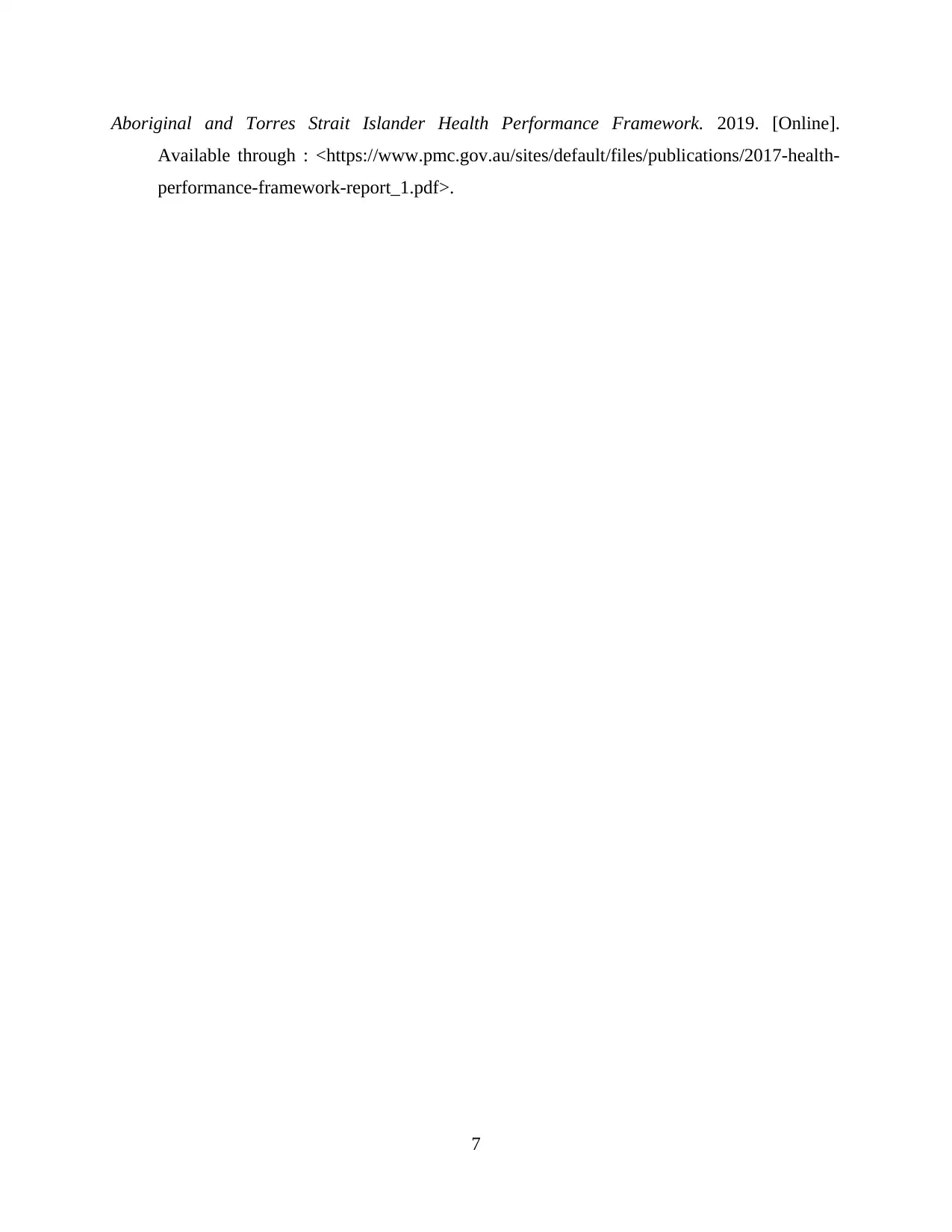
Aboriginal and Torres Strait Islander Health Performance Framework. 2019. [Online].
Available through : <https://www.pmc.gov.au/sites/default/files/publications/2017-health-
performance-framework-report_1.pdf>.
7
Available through : <https://www.pmc.gov.au/sites/default/files/publications/2017-health-
performance-framework-report_1.pdf>.
7
⊘ This is a preview!⊘
Do you want full access?
Subscribe today to unlock all pages.

Trusted by 1+ million students worldwide
1 out of 9
Related Documents
Your All-in-One AI-Powered Toolkit for Academic Success.
+13062052269
info@desklib.com
Available 24*7 on WhatsApp / Email
![[object Object]](/_next/static/media/star-bottom.7253800d.svg)
Unlock your academic potential
Copyright © 2020–2026 A2Z Services. All Rights Reserved. Developed and managed by ZUCOL.





